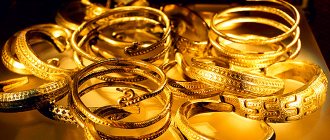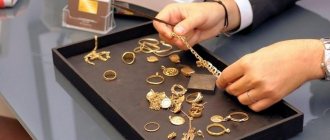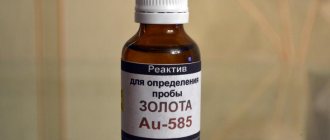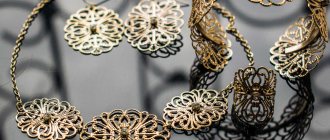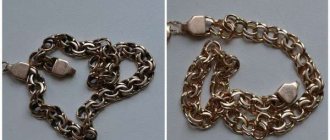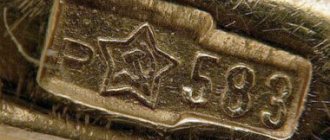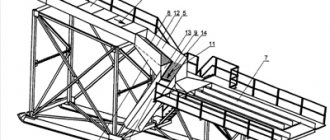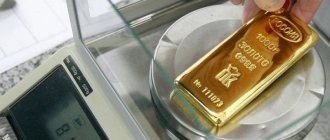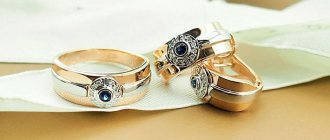Method of using reagents
Three types of reagents are used to test gold:
- acidic or standard;
- chlorine gold;
- potassium iodide.
Depending on the reagent used, it will take different times to determine the sample. Potassium iodide acts the fastest - 2-5 seconds. The slowest reaction is for the acid reagent intended for gold samples above 750 and the metal itself.
Acid reagent for determination of gold and platinum
In order to determine by eye which reagent is needed, you need to know some of the characteristics of gold. The higher the standard, the softer the metal. The density will be higher for gold of higher purity. In order to determine the density of a metal, it is necessary to weigh the product on a scale and then in a liquid. If we divide one value by another we get density. Next, to determine the sample, use the following method:
- If the gold content is about 37 percent, which corresponds to 375 standard, then the metal is first tested with gold chloride, and then with a reagent for 375 standard.
- For the 500th sample, the same order is used - gold chloride, then the reagent for this sample. Since the 500 sample most often represents the 585 sample, but slightly contaminated, it can therefore be additionally tested with an acid reagent for this sample.
- Gold alloys that are white in color and contain supposedly up to 60% gold are called gold chloride.
- Gold alloys of 750 standard, including white gold - with a reagent up to 750 standard, you can check with gold chloride to determine whether the product is a gross fake.
- Alloys that contain more than 80% gold are treated with a solution of potassium iodide, as well as with 750 standard, it is possible to clarify using gold chloride.
Acidic reagents
All acid reagents have the same type of effect; they leave a light spot on the metal of the sample for which they are intended, or do not react at all. They also do not react to metal of a higher standard and leave a brown spot if the sample is less than that for which the reagent is intended. In its preparation we use:
- nitric acid density 1.4;
- hydrochloric acid, density 1.19;
- distilled water.
For different gold samples, solutions are prepared in the following proportions:
| Try | Nitric acid | Hydrochloric acid | Water |
| 375 | 0.595 | 0.405 | |
| 500 | 1 | ||
| 583/585 | 0.46 | 4 drops | 0.54 |
| 750 | 0.593 | 0.011 | 0.396 |
| 833 | 0.687 | 0.013 | 0.3 |
| 900 | 0.692 | 0.013 | 0.295 |
| 958 | 0.787 | 0.02 | 0.193 |
The acid reagent for 500 gold can also be considered universal for any sample. It is a pure nitric acid that will react to all types of gold below 583 purity. It is the cheapest and most readily available. On all alloys containing less than half gold, bubbles will appear under the drop. The lower the sample, the more intense the release will be.
If there is no gold present at all, the reaction will occur instantly and a green foam will appear, which will be accompanied by hissing. On silver of a low standard it will leave a grayish spot, and with a standard below 800 the reaction will be the same, with bubbles. On silver below 600 fineness, nitric acid will boil. Such a reagent is often used as a starting reagent for the approximate determination of the metal being studied.
To main§ 15. Assay reagents
Assay reagents at all jewelry enterprises are a necessary tool for determining samples of precious metals. In table Table 7 shows the compositions of acid reagents used to determine the gold sample.
Table 7
Acid assay reagents used to determine the gold sample
For gold-copper alloys of 583 standard, an acid reagent of the following composition is used: HNO3 (density 1.4) - 46 ml; HCl (density 1.19) - 4 drops; distilled water - 54 ml. For platinum 950, the same reagent is used as for gold 958. Salt based reagents. Chloride gold reagent.
Composition AuCl - 23 g;
distilled water - 1000 ml. Preparation of reagents: metallic gold 999.9 standard in small pieces or in finely rolled form is dissolved in a mixture of hydrochloric and nitric acids (4 parts HCI, density 1.19, and 1 part HNO3, density 1.38 - 1.40 ). Dissolution is carried out by gently heating the solution until a dark yellow mass of gold chloride is obtained. After complete dissolution of gold, the solution is evaporated until the precipitate begins to crystallize. Then the precipitate is dissolved in distilled water in the specified ratio. The “gold chloride” reagent is used for testing gold products of the 583rd standard, for preliminary testing of products of questionable content and for approximate determination of the sample of products by the color and intensity of the stain below the 583rd standard. Reagent “silver nitrate”
Compositions: 1. AgNO3 - 0.45 g;
distilled water - 100 ml. — For testing silver of 750 standard. 2. AgNO3 - 0.5 g; distilled water - 100 ml. — For testing silver of 800 standard. 3. AgNO3 - 0.7 g; distilled water - 100 ml. — For testing silver of 875 standard. 4. AgNO3 - 0.75 g; distilled water - 100 ml. — For testing 916 silver. To enhance the effect of the reagents, add a drop of nitric acid to them. Preparation of reagents: 10 g of finely flared and finely chopped silver of 999.9 standard are dissolved in 15 ml of chemically pure nitric acid (density 1.25). Dissolution occurs with low heating. During the dissolution process (in a closed vessel), silver nitrate crystallizes, which is allowed to cool to room temperature and dissolved in distilled water. Then the solution is filtered and evaporated at a temperature of 100°C until a thick crystalline mass is formed. Further evaporation occurs with constant stirring until the sediment becomes free-flowing. For use as reagents, the precipitate is dissolved in the indicated proportions. Previous page
| table of contents | Next page |
Chlorine gold
Gold chloride is often used to test products whose fineness and composition are unknown. It is most effective when you need to identify fakes, for example, if the product is only coated with a layer of gold or there is no metal at all. This reagent is used if it is necessary to test 500 and 583/585 samples of gold.
Chlorine gold
The gold chloride reagent is not only used for determining gold; it can also be used to determine other types of precious metals and alloys. In order to carry out such an analysis, a drop of the reagent is applied to the surface of the metal being tested and waited. After some time, a spot of a certain color forms, by which they determine what kind of metal they are dealing with.
| Metal color | Spot color | Reaction time | Detectable metal |
| White | Dark green | Up to 2 sec. | High sterling silver |
| Yellow to dark yellow, accompanied by gas evolution | Up to 2 sec. | Aluminum | |
| Black | Approximately half a minute | Tin | |
| Grayish white | Has no effect | 30–40 sec. | Platinum |
| From yellow, quickly becomes very dark | Up to 2 sec. | Zinc | |
| Bluish white | Dirty yellow | Up to 2 sec. | Lead |
| Yellow | Has no effect | Up to 2 sec. | High-grade gold alloyed with silver |
| Chestnut | Up to 6 minutes | Low-grade alloys of gold with silver and copper | |
| Black | Up to 2 sec. | Brass | |
| Pale yellow | Black | Up to 2 sec. | Low-grade silver, in a ligature - copper |
| Red | Has no effect | Up to 2 sec. | High grade gold alloy. The ligature contains copper |
| Golden | Up to 6 minutes | Low grade gold alloyed with copper | |
| Black | Up to 2 sec. | Copper |
The lower the gold grade, the darker the stain will appear on the surface of the metal. On gold of the standard and most common standard 585, gold chloride will give a brown stain, on white gold of the same standard - an orange one. At 500 it is dark chestnut; at 375 gold chloride will leave a green spot. This reagent interacts well with gold and silver and has no effect on platinum and platinum group metals. It also reacts poorly with some types of steel.
We determine the gold sample at home and in the laboratory
Gold is one of the most popular precious metals these days, which is widely used in jewelry production. High-quality gold jewelry is very valuable, so counterfeits of gold jewelry are increasingly appearing on the domestic and foreign markets. In this regard, it is very important to know how to determine the gold standard, and in some situations, how to test the gold standard at home.
Testing system in Russia

Precious metals assay system
The most important confirmation of the authenticity of gold jewelry is the sample. Assays are mandatory on all jewelry made of precious metals that go on sale.
The Russian assay system provides for the following gold samples:
- 375;
- 500;
- 585;
- 750;
- 958;
- 999.
The digital sample value corresponds to the content of pure precious metal in one kilogram of jewelry, presented in grams.
The Russian testing system is called metric. Along with it, there are also spool and carat testing systems. The correspondence of samples for each of these systems is as follows:
- 375 standard in the metric system corresponds to 36 standard - in the spool system, which is equal to 9 carats;
- 500 standard in the metric system corresponds to 48 standard - in the spool system, which is equal to 12 carats;
- 585 standard in the metric system corresponds to 56 standard - in the spool system, which is equal to 14 carats;
- 750 standard in the metric system corresponds to 72 standard - in the spool system, which is equal to 18 carats;
- 958 standard in the metric system corresponds to 92 standard - in the spool system, which is equal to 23 carats;
- 999 standard in the metric system corresponds to 96 standard in the spool system, which is equal to 24 carats.
However, the presence of a hallmark on a piece of jewelry, unfortunately, in our time does not guarantee its authenticity. Of course, the right action when choosing gold jewelry would be to go to a specialized store or salon.
We recommend reading: All about gold leaf - what is it
Usually, to determine the gold purity of a particular piece of jewelry, it is necessary to contact specialized government inspections, whose employees will conduct appropriate chemical experiments to help determine the gold purity in the jewelry.
However, it is not always possible to turn to professionals for help, and the need arises to independently establish the authenticity of gold jewelry.
You can determine the gold standard yourself at home using:
- magnet;
- iodine and vinegar;
- of bread;
- similar item;
- touchstone;
- reagents.
Next we will talk about each of the mentioned methods separately.
Magnet check
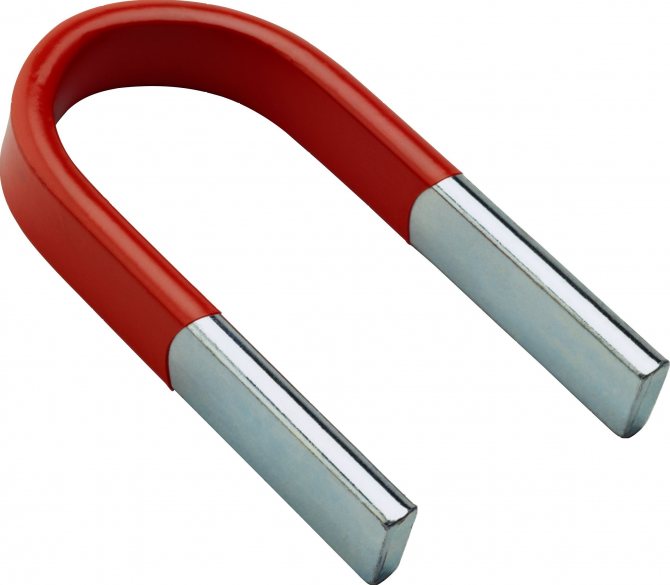
Magnet
Verifying the authenticity of gold jewelry with a magnet involves simple manipulations that involve bringing a magnet to the item and determining whether it is magnetized or not.
Products made from genuine gold, as well as jewelry that contains a minimal amount of impurities, should not be magnetized.
If the product sticks to the magnet, it means that its composition is dominated by foreign impurities.
Checking with iodine and vinegar

Gold ring after testing with vinegar
Exposure to iodine or vinegar should not in any way affect the structure or appearance of gold jewelry.
If a drop of one of these solutions provokes the formation of darkening, it means that you are not holding a genuine gold product in your hands or its content is not high.
It is important! If the standard of your jewelry is 585 or lower, we do not recommend testing with iodine; stains may remain, which will then need to be removed with ammonia.
Bread test
This is perhaps the longest way to check gold jewelry for authenticity.
We recommend reading: Exchange quotes for precious metals in the first half of August 2015
To conduct this experiment, you need to take a piece of fresh Borodino bread, after kneading it, put a piece of jewelry in it, and leave it in a cool and dark place for several days.
After this, you need to break the stale bread. If the product has acquired a green color, it means it is made of base metal, or with a large consistency of foreign impurities.
Similar subject
You can establish the authenticity of a piece of jewelry by comparing it with a product whose authenticity you have no doubt about.
To do this, you need to take two things (verifiable and genuine), and alternately draw lines with them on any solid object. If the clarity and color of the lines match, then both products are original, but if not, then one of the products is a fake.
touchstone
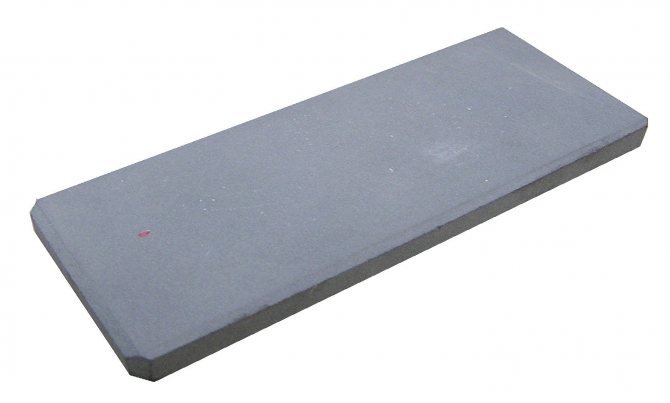
Touchstone
The most popular method of checking the purity of gold in jewelry is using a touchstone test. The versatility of this method lies, first of all, in the fact that in this way no harm is caused to the quality of the jewelry.
To conduct this experiment, you need to take a black block of siliceous slate, and draw a line on the surface of which with decoration. The set with siliceous slate always comes with a reference needle, which must be used to draw a line next to the one drawn by the jewelry.
If the two drawn lines are identical, then you have in your hands a piece of jewelry of 585 standard or higher. Otherwise, we recommend that you contact specialists for analysis, or resort to more serious methods yourself.
We recommend reading: Types of metals for jewelry
Video on how to test gold at home
Other verification methods
One of the alternative ways to more accurately determine the sample of yellow precious metal in jewelry is to check using a special device - the GXL-18 56.762X gold detector.
This device is a digital detector that, in a fairly short time (five to ten seconds), allows you to determine a quantitative indicator of the pure gold content in a product.
The device presents the results of the study in carats. The calculation is made based on the following ratio: 333-750 standard corresponds to 6-18 carats, respectively.
A characteristic feature of the detector is that it is able to distinguish true gold jewelry from gold-plated jewelry.
Typically, the detector is used in the jewelry industry to determine gold in various alloys with high accuracy. The sample determination process itself is based on an electrochemical reaction. It is often used in their activities by pawnshops, workshops and buying stores.
Another chemical way to test the sample of gold jewelry is acid reagents, which can be purchased in specialized stores.
Such reagents are produced in accordance with 375, 750 and 958 samples of gold. When the product is exposed to an acidic reagent, spots of a light brownish tint appear on the product. The intensity of the stain depends on the gold standard: the lower it is, the more intense the color of the stain.
A variety of ways to check the purity of gold in jewelry makes it quite easy to determine whether the gold product you purchased is genuine, and whether the hallmark marked on the product corresponds to reality.
Prices and hallmarks of white gold
Gold mining in Magadan in 2014
What are the types of gold alloys?
Potassium iodide solution
This solution is used to test high purity gold alloys, as well as to identify good counterfeits, that is, those made from alloys that are inert to most substances. The solution works like this:
- On an alloy with a gold content above 90%, the reagent forms a bright red spot.
- On gold alloys with a gold content of 80 to 90% there is a burgundy stain. This gold alloy is often found in scrap left over from dental crowns or dentures.
- On counterfeits made from alloys that are highly resistant, a black or green spot forms, but turns black. The reaction is accompanied by the release of bubbles.
